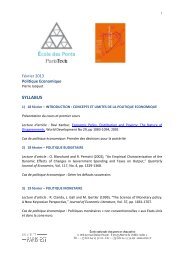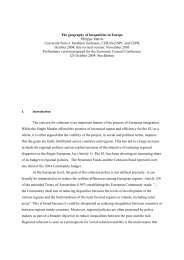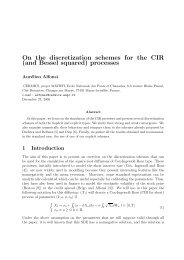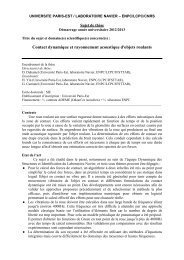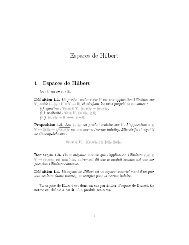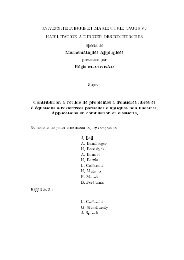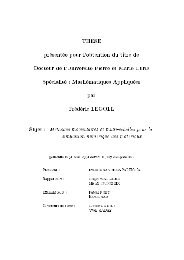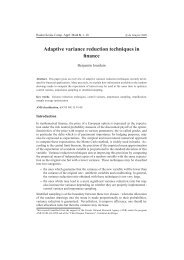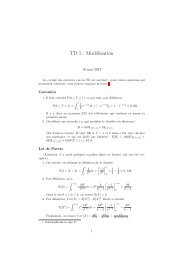You also want an ePaper? Increase the reach of your titles
YUMPU automatically turns print PDFs into web optimized ePapers that Google loves.
18 Chapitre 2 : Analyse numérique dans un cas simplié<br />
for k = 0, 1, 2, . . .<br />
If k is even, perform a forward step :<br />
y k1 ∈ arg min {F (z, x k2 ) : ‖z‖ = 1, z T x k2 = 0},<br />
y k2 ∈ arg min {F (y k1 , z) : ‖z‖ = 1, z T y k1 = 0},<br />
If k is odd, perform a reverse step :<br />
y k2 ∈ arg min {F (x k1 , z) : ‖z‖ = 1, z T x k1 = 0},<br />
y k1 ∈ arg min {F (z, y k2 ) : ‖z‖ = 1, z T y k2 = 0}.<br />
If k is either even or odd, perform a global step :<br />
end<br />
z k (s) = 1 √<br />
1+s 2<br />
(y k + sd), d = ±<br />
where<br />
s k ∈ arg min {F k (s) : s ∈ [0, −ρF ′ k (0)]}.<br />
Fig. 2.1 The decomposition algorithm.<br />
[<br />
]<br />
y k2<br />
, x<br />
−y k+1 = z(s k ),<br />
k1<br />
where s k is the stepsize.<br />
Notice that when H 1 and H 2 are 2 by 2 matrices, the 4 vectors in (2.3) span R 4 .<br />
Hence, in the 2 by 2 case, the global step yields a global optimum for (2.1). More<br />
generally, we nd that the local steps steer the iterates into a subspace associated<br />
with the eigenvectors of H 1 and H 2 corresponding to the smallest eigenvalues, while<br />
the global step nds the best point within this low dimensional subspace.<br />
Ideally, the stepsize s k is the global minimum of F k (s) over all s. However, the<br />
convergence analysis for this optimal step is not easy since ‖x k − x k+1 ‖ could<br />
be on the order of 1 for all k. For example, if H 1 = H 2 , then F k (s) is constant,<br />
independent of s; consequently, any choice of s is optimal, and there is no control<br />
over the iteration change. To ensure global convergence of the algorithm, we restrict<br />
the stepsize to an interval [0, −ρF k ′ (0)], where ρ is a xed positive scalar. In other<br />
words, we take<br />
s k ∈ arg min {F k (s) : s ∈ [0, −ρF k(0)]}. ′ (2.6)<br />
Notice that s k = 0 when F k ′ (0) = 0 and the global step is skipped. In practice,<br />
we observe convergence when s k is a global minimizer of F k . The constraint on the<br />
stepsize is needed to rigorously prove convergence of the iteration. For reference, the<br />
complete algorithm is recapped in Figure 2.1.<br />
Since F is a pure quadratic, the objective function satises<br />
F (x 1 , x 2 ) = F (−x 1 , x 2 ) = F (x 1 , −x 2 ) = F (−x 1 , −x 2 ).<br />
Hence, if y kj is a minimum in a subproblem at iteration k, then so is −y kj . In<br />
order to carry out the analysis, it is convenient to choose the signs so that following



